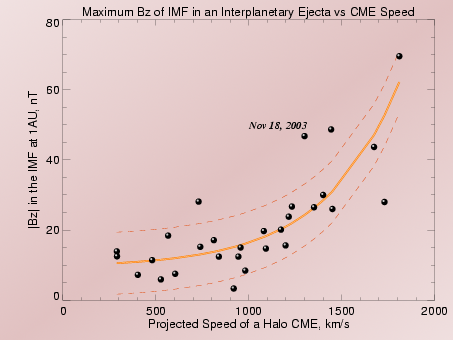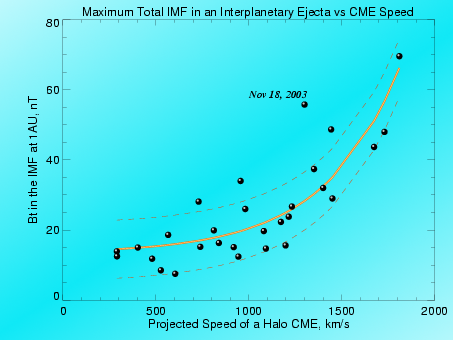|
Space Weather Research at BBSO
|
Shortly after coronal mass ejections (CMEs)
were discovered, researchers began to realize that CMEs are directly
related to the occurrence of intense disturbances in Earth's magnetosphere
called geomagnetic storms. The primary cause of these storms is long
intervals of southwardly directed magnetic field imposed on the Earth's
magnetosphere by solar ejecta. Since CMEs very often have a well organized
magnetic structure, there may or may not be a strong southward component of the
magnetic fields present in the solar wind. Therefore our knowledge of CME's
orientation is critical in predicting whether or not a solar
ejecta will be associated with a storm. On the other hand, the magnitude of a
storm is determined by the velocity, density and intensity
of the southward Bz component in the solar wind.
Magnetic Field Orientation.
Although there is growing evidence of a strong correspondence between
the solar and CME magnetic fields, no well accepted scheme to predict
the internal magnetic structure of a CME has been
developed so far.
CMEs are often observed in white-light coronagraphs as elongated structures. It is
suspected that this elongation indicated the orientation of the underlying
magnetic flux rope. We measured tilt of these elongated CMEs, relative to the
solar east-west line and compared them to the tilt of the corresponding post
eruption arcades (PEA). This research project in BBSO is led by
Vasyl Yurchyshyn in collaboration with Valentyna Abramenko.
In Figure 1 we show these measurements in three panels, which represent (from left
to right) disk halo CMEs, off-disk halo CMEs and partial CMEs. In all three
cases the data points are mainly focused near the bisector, which indicates
that, in general, the halos are elongated along the axis of the corresponding
EIT post eruption arcades (Yurchyshyn et al.
2007). It is also additional evidence that the white-light structure of halo CMEs may bear
information on the geometry of the underlying flux rope.
 |
Figure 1.CME
tilt angles plotted versus those of PEAs. The plots are (from left to right)
for disk halo CMEs that originated within a 30 deg circle centered at the disk
center, off-disk halo CMEs and partial CMEs. Black (gray) symbols represent
events launched from southern (northern) hemisphere. The partial halos are
plotted with pie segments, whose orientation indicates the solar disk quadrant
where they originated. The horizontal error bars are standard deviations of
measurements associated with each CME event. Vertical error bars represent
absolute error of measurements of PEA orientations, which is accepted for all
events to be 20 deg.
Magnetic Field Intensity.
Our studies produced a relationship (Figure 2) between the hourly averaged
magnitude of the Bz component in 14 MCs and the expansion speed of the
corresponding CMEs, launched from the central part of
the solar disk (Yurchyshyn et al., 2003; 2004). The hourly averaged magnitude Bz
can be estimated as Bz = 9.3+0.6*exp(v/404), where v is the expansion speed (km/s)
of a CME measured in the plane of the sky from LASCO C3 images.
Figure 2. Hourly averaged absolute values of the Bz component (left) and
the peak values of the total field Bt, (right) in MCs plotted
versus the expansion speed of the associated CMEs.
More details can be found here
and relevant publications are here.
This research was supported by NASA
LWS TRT Grants awared in 2005 and 2008;
NASA HGI Grant (2008);
NSF Space Weather Grant (2002) and several NSF ATM Grants.
 Send Comments to:
[email protected]
Send Comments to:
[email protected]
© BBSO/NJIT - Last modified: March 8, 2009.



